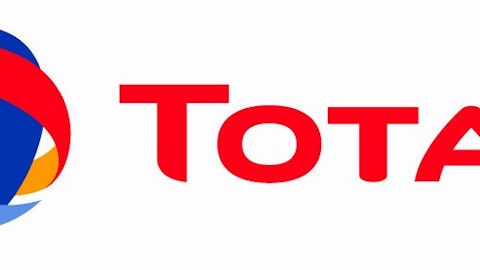Despite efforts to change the way we use energy, we still need oil. A lot of it.
Fortunately, the Kashagan oilfield — the largest oil discovery in the past 30 years — just started production. Unfortunately for those involved in the project, it may not turn out to be as promising as originally thought. Let’s look at what this new discovery means to the companies that hope to turn a profit from it.
“Cash all gone”

Source: Eni S.p.A Media Relations.
The Kashagan field in the Caspian Sea has been one of the biggest cautionary tales for the future of oil. While it holds a ton of promise with more than 13 billion barrels of recoverable oil, the project so far has been described as a boondoggle at best. It took the consortium of companies working on the project more than 12 years to get the first drop of oil out of the ground. Also, once the project hits its target capacity of 375,000 barrels per day, the costs will have swelled to more than $80,000 per barrel of capacity, which is more than 5 times what it costs for oil to come from places such as Saudi Arabia. The extremely high costs on this project coupled with how long it has taken to bring online has given it the nickname “Cash all gone.”
There are two major reasons this project has struggled to get off the ground: technical challenges of the project and the highly technical term known as “too many chefs in the kitchen.” Harsh winter conditions similar to exploring in the Arctic, an extremely high-pressure reservoir, and hydrogen sulfide levels high enough to kill a human in 30 seconds if a leak were to occur have made Kashagan quite possibly the most technically challenging oil field ever encountered.
Also, to comound these problems, there isn’t a clear leader of the project that can steer its investment deicisions. Exxon Mobil Corporation (NYSE:XOM), Royal Dutch Shell plc (ADR) (NYSE:RDS.A), Eni SpA (ADR) (NYSE:E), TOTAL S.A. (ADR) (NYSE:TOT), and Kazakh national oil company KazMunaiGas each have a 16.81% working interest in the project. This has led to problems involving investment decisions and project mangement. Both Exxon Mobil Corporation (NYSE:XOM) and Royal Dutch Shell plc (ADR) (NYSE:RDS.A) have been extremely disappointed with the results, to the point that they have threatened to pull out of the project altogether on a couple of occasions, and ConocoPhillips (NYSE:COP) did get out this year by selling its $5 billion stake in the project to China National Petroleum.
A gusher of capital for a trickle of oil
Even though the project plans to increase production to 1.5 million barrels per day sometime next decade, it’s unlikely that having this project come online will have a significant impact on production numbers for any of the companies. Right now, Eni SpA (ADR) (NYSE:E), the company responsible for the first phase of development, believes the project will ramp up to 180,000 barrels per day and get to the 375,000 target, although dates are not completely certain. That means that each of the companies I’ve mentioned here will net about 63,000 barrels per day once the first phase is operational, which is hardly going to move the needle for these companies. Exxon Mobil Corporation (NYSE:XOM)’s total production last quarter averaged more than 4 million barrels per day.
With almost $50 billion invested in the project so far and so little to show for it, the one way these companies will be able to make a decent return will be the project’s extremely long time horizon. Even if it ramps up to 1.5 million barrels per day, production at this field is expected to last for several decades, so down the road those big bucks invested today might seem worth it. Exxon Mobil Corporation (NYSE:XOM) and Royal Dutch Shell plc (ADR) (NYSE:RDS.A) estimate that they will need to be involved in the project beyond 2040 to make a reasonable return on Kashagan.
What a Fool believes
For investors looking at the companies involved in this project, Kashagan may end up being more of a burden than a blessing. The government has hinted at terminating contracts in the event of an accident, which would translate to multibillion-dollar writedowns if any thing were to happen. Also, each of these companies has projects in the pipeline that will have much more impact on the bottom line in the short to medium term. In all reality, Kashagan may end up being more of a liability than a bankable asset. It’s still going to take several billions of dollars to get the project up to peak capacity, so we are still years away from seeing how profitable Kashagan really is.
The headaches involved in investing in overseas oil and gas projects make investing in the American energy boom that much more compelling. The problem with investing here, though, is finding the companies that have the legs to stand the test of time. For this reason, we have put together a comprehensive look at three energy companies set to soar during this transformation in the energy industry. Let us help you discover these three companies that are spreading their wings by checking out our special report, “3 Stocks for the American Energy Bonanza.” Simply click here and we’ll give you free access to this valuable report.
The article 13 Billion Barrels of New Oil Plague the Petroleum Industry originally appeared on Fool.com and is written by Tyler Crowe.
Fool contributor Tyler Crowe has no position in any stocks mentioned. You can follow Tyler at Fool.com under the handle TMFDirtyBird, on Google +, or on Twitter @TylerCroweFool. The Motley Fool recommends Total. Try any of our Foolish newsletter services free for 30 days. We Fools don’t all hold the same opinions, but we all believe that considering a diverse range of insights makes us better investors. The Motley Fool has a disclosure policy.
Copyright © 1995 – 2013 The Motley Fool, LLC. All rights reserved. The Motley Fool has a disclosure policy.



